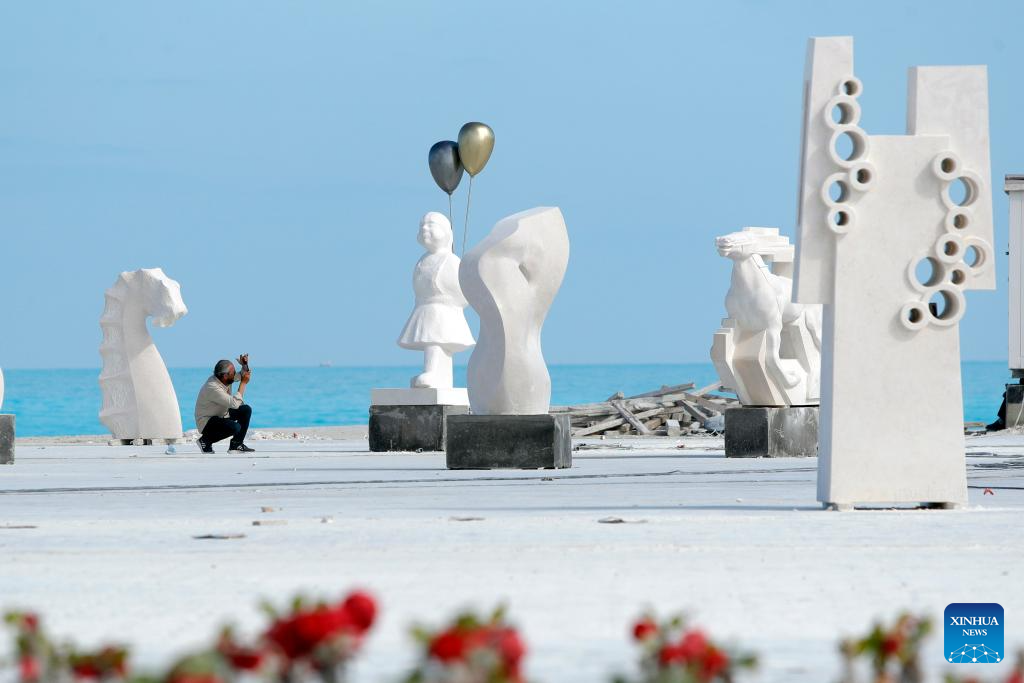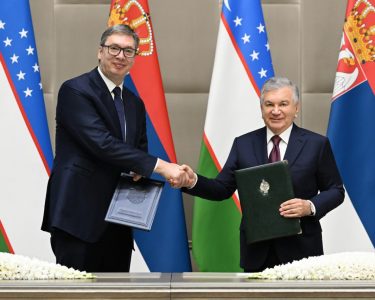by Mahmoud Fouly
NEW ALAMEIN, Egypt, Oct 29 (NNN-XINHUA) – Under the Mediterranean sky, rows of white sculptures rise, along the seaside promenade of New Alamein, an emerging city. Abstract forms and graceful human figures stand in silent dialogue with the sea, turning the esplanade into an open-air gallery that speaks to New Alamein’s modern identity.
Among them stands a striking piece by Egyptian artist, Wael El Shafey: a mother and her child, carved from Galala limestone, their bodies intertwined, heart-shaped hollows symbolising love and continuity.
“The ancient Egyptians passed their legacy through sculpture and art,” El Shafey told Xinhua. “By creating public sculptures now, we’re continuing that tradition, making art a living part of the public space.”
His work, titled “Egypt: Motherhood and Continuity,” is one of more than 20 large-scale sculptures created during the 10th Egypt Sculpture Symposium, which concluded here yesterday, after nearly three weeks of work. Twenty-two artists from Italy, France, Spain, China, Japan, Türkiye, Mexico, Georgia, and Serbia participated, using local limestone and metal to shape their visions.
Mohamed Hemida, founder and organiser of the symposium, emphasised its public-facing mission. “I’ve always believed art should leave closed galleries and reach the street. People come here, see the artists working, take pictures, and feel part of the process. It’s both art and beautification at once,” he said.
The sculptures, ranging from a recycled-iron eagle to a marble horse captured mid-gallop, will soon adorn the city’s streets, promenades, and public spaces, each bearing the artist’s name and the symposium’s date.
Turkish sculptor, Songul Telek, was still chiseling her abstract work, “Changing Life,” a day before the closing.
Telek, pausing to wipe marble dust from her hands, said, “It’s amazing to interact with artists and cultures from across the world through art.”
Her 2.5-metre-high limestone piece explores transformation: “Life is always changing; each moment carries traces of the one before, while renewing itself. That’s what my work symbolises.”
As the artists put the final touches on their works, locals and visitors alike stopped to watch. Vladimir Serov, a Belarusian resident, cycled over to take photos.
“It’s not finished yet, but it’s already beautiful. I think both residents and tourists will enjoy these shapes when they are displayed across the city,” he said.
At the closing ceremony, officials and cultural figures praised the symposium for visually defining New Alamein as a city of peace and development.
Osama Ali, head of the Beautification Sector at Egypt’s New Urban Communities Authority, under the Ministry of Housing, called the symposium “a valuable idea” that creates “a meeting point between art, beauty, and modern urbanism.”
“The city needs aesthetic landmarks that harmonise with its architecture and natural surroundings,” he told Xinhua. Similar efforts, he noted, are planned for other new cities across Egypt.– NNN-XINHUA






